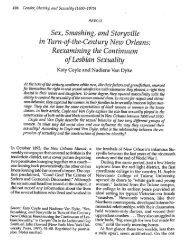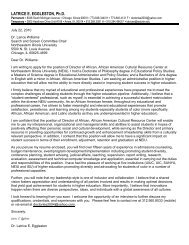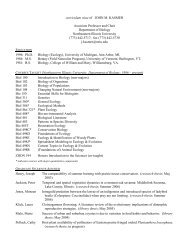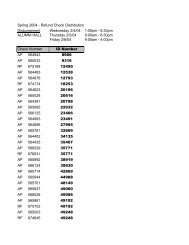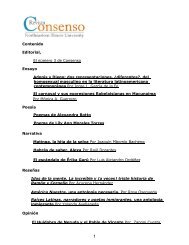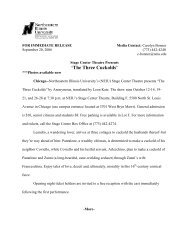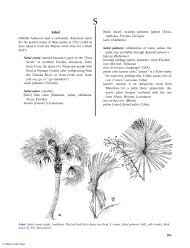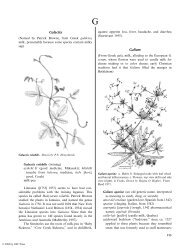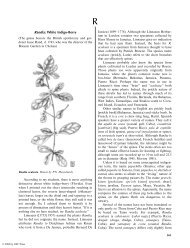Herba Cana - Northeastern Illinois University
Herba Cana - Northeastern Illinois University
Herba Cana - Northeastern Illinois University
You also want an ePaper? Increase the reach of your titles
YUMPU automatically turns print PDFs into web optimized ePapers that Google loves.
© 2004 by CRC Press<br />
The Ethnobotany 513<br />
co:yihiskopóskî [tcoihiçkopoçki] (Mikasuki; cognate<br />
to Creek cule, pine, esse, leaf, lopockuce,<br />
little)<br />
pitch pine (called ‘‘P. rigida,’’ which is not in<br />
Florida; the trees were ‘‘low, poor timbered tree,<br />
but produces turpentine and tar,’’ which seems<br />
best to describe this species, cf. Williams [1837]<br />
1962)<br />
sand [scrub] pine<br />
Pinus echinata (spiny)<br />
ácuwe [etcuwe’, ícuwe] (Catawba)<br />
choyyihissi hobaski (choyyi, pine, hissi, hair<br />
[needle], hobaski, short, Alabama); coyyí acakí<br />
(coyyí, pine, acakí, dwarf, Koasati)<br />
[long-tag, shortleaf, short-leaf, yellow] pine<br />
taklaha (tiak, pine, lakna, yellow, Choctaw)<br />
teetpa hitcuwe’ (chewed pine, the resin, Catawba;<br />
also applied to P. palustris)<br />
Pinus elliottii (commemorates Stephen Elliott,<br />
1771 /1830, professor in Charleston who published<br />
a flora of South Carolina and Georgia in<br />
the 1820s)<br />
chooye enlepaatooche, chooye ebeele (pine branch<br />
tips, Mikasuki)<br />
chooye [co:yí] (Mikasuki); cule [colí, chuli]<br />
(Creek); tcuyi (Alabama)<br />
cule emohlowakuce (cule, pine, em, its, elvcce,<br />
branch, Creek)<br />
este lopockuce or este-lopocke emeto (‘‘where the<br />
little people live’’; from este, person, lopockuce,<br />
small, em, its, eto, tree, Creek)<br />
nat’tsi (Cherokee)<br />
slash pine (Florida)<br />
yaat-hoboske emahe (where the little people live,<br />
Mikasuki)<br />
Pinus glabra (smooth)<br />
spruce pine (Florida)<br />
Pinus palustris (of swamps, a misnomer)<br />
atcuwe nu’re (pine fat [rich], Catawba); ansudi’<br />
[ansûdi’] (generic for pine or P. palustris, Biloxi);<br />
ansudi’ nitan’xti (Biloxi)<br />
choyyihissi hobaski (choyyi, pine, hissi, hair [needle],<br />
hobaski, long, Alabama)<br />
choyyinaani (choyyi, pine, naani, male, Alabama);<br />
coyyí ná:ni (coyyí, pine, ná:ni, male, Koasati)<br />
longleaf pine (southeastern United States)<br />
ne’c mañ ne’c (ne’c, tree, mañ, long, ne’c, tree,<br />
Atakapa)<br />
tiak fanya (tiak, pine, fani, squirrel, Choctaw);<br />
tiak hobak (tiak, pine, holba, resembling, Choctaw)<br />
yellow pine (once the ‘‘principal timber, used for<br />
plank and scantling in the southern states; and<br />
also produces turpentine and tar,’’ Williams<br />
[1837] 1962; is this a translation of the Koasati<br />
coyyilá:na, coyyí, pine, lá:na, yellow?)<br />
Pinus serotina (late, alluding to the cones typically<br />
not opening until burned)<br />
many cored pine (Williams [1837] 1962)<br />
[marsh, pond] pine<br />
Pinus taeda (Latin for torch; ancient name for a<br />
resinous pine)<br />
choyyihoba (choyyi, pine, hoba, castrated, Alabama)<br />
coyyí ná:ni (coyyí, pine, ná:ni, male, Koasati)<br />
loblolly pine (‘‘has much sap,’’ Williams [1837]<br />
1962)<br />
oldfield pine (the plants quickly re-seed and sprout<br />
in old agricultural areas)<br />
Pines are among the most widely used of plants<br />
throughout their range (Standley 1920 /1926, Moerman<br />
1998). Many pines have been employed in North<br />
American medicines, e.g., Pinus palustris and P. rigida<br />
have stimulant, laxative, diuretic, pectoral, vermifuge,<br />
discutient, antiherpetic, detergent, baslasic, and vulnerary<br />
properties (Vogel 1970). Pine tar was in the U.S.<br />
Pharmacopoeia between 1820 and 1950 and has been<br />
in the National Formulary from 1950 to the present; it<br />
is considered an antibacterial, irritant, parasiticide,<br />
and expectorant.<br />
The earliest records of pines being used in Florida<br />
were among the Glades people (Gilliland 1975, Hogan<br />
1978, Austin 1980). Wood is the best-known product,<br />
although there are numerous other uses by people<br />
(Hamel and Chiltoskey 1975, Austin and Smith 1997).<br />
The inner bark and roasted seeds were eaten as famine<br />
food. Needles were cooked or eaten raw. Resin was an<br />
effective salve alone or as a medicine base, and teas<br />
from leaves were expectorants, antidiarrheics, and<br />
vermifuges. Lighter pine (the resinous heartwood)<br />
has long been used as fuel.<br />
The Creeks used the wood for beams, ball poles,<br />
houses, torches, bighouse seats, baskets, and religious<br />
scarification (Swanton 1928a). The Seminoles continued<br />
those practices (Sturtevant 1955). In addition, the<br />
Seminoles formerly used the resin as arrow point glue<br />
and extracts of bark for tanning. When Sturtevant<br />
(1955) worked with the Miccosukee, they were using





